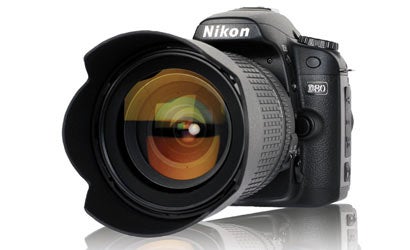Nikon D80 Competitive Set
See how the Nikon D80 stacks up against the Canon Rebel XTi, Pentax K10D and Sony Alpha 100.

We may earn revenue from the products available on this page and participate in affiliate programs. Learn more ›
Canon EOS Digital Rebel XTi
Canon’s first consumer-level DSLR to break the 10MP barrier, the Rebel XTi, is set to sell for a doorbuster $800 body only, $900 with 18-55mm kit lens — a $200 savings over the Nikon D80. This latest Reb has both self-cleaning sensor and software dust-mapping (the D80 has only the latter). And, with an AF system from the Canon 30D, we expect it will focus slightly faster than the D80 down to EV 0, after which the Nikon will have the advantage. In addition, the Canon lens line has greater depth in image-stabilized optics. But we think the Nikon D80 body is sturdier, and the D80’s TTL flash system is superior — Canon’s built-in units still don’t function as wireless triggers. We’ll see if the Reb can match the Nikon’s image quality when we test the camera.
Check specs and pricing on the EOS Digital Rebel XTi in our Buying Guide.
Pentax K10D
While we are still waiting for a production model K10D to test, at first glance Pentax’s surprise 10-shooter looks like a real competitor. The K10D has better environmental sealing than the Nikon D80, and it comes with both self-cleaning sensor and sensor-based anti-shake, which the D80 lacks. It will also sell for about $100 less than the D80. The K10D provides wireless TTL flash control with the built-in unit, although the D80’s system is the more sophisticated. Pentax promises improved AF with the K10D, so we’ll have to wait and see how it compares with the Nikon’s. While Pentax has a deep lens line, it’s no match for the Nikon catalog. And the K10D will have to perform very well indeed to match the D80’s image quality.
Check specs and pricing on the K10D in our Buying Guide.
Sony Alpha 100
Sony’s groundbreaking Alpha 100 stacks up well against the Nikon D80, and not just in savings ($150 less). Sony’s advantages include self-cleaning CCD (the Nikon has software dust mapping, but this take both forethought and post-production trouble), on-the-fly dynamic range fixes (Nikon’s D-Lighting can only boost shadows, and only after the shot), and, most important, CCD-based anti-shake that works with any lens (Nikon’s Vibration Reduction is available in only a few lenses). The Sony’s AF is slightly faster throughout the EV range, although the Nikon AF is still better in motion tracking, has more zones, and can focus down to EV -2. Their TTL flash capabilities are comparable. The Nikon has the clear advantage in image quality (10 percent higher resolution and awesome noise control-moderately low at ISO 3200, a sensitivity the Sony doesn’t even have), better in-camera color controls, and a much bigger lens catalog.
Check specs and pricing on the Alpha 100 in our Buying Guide.
See the full test results on the Nikon D80.